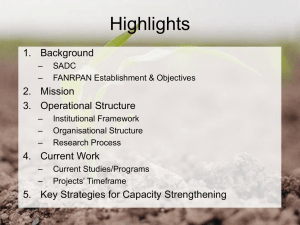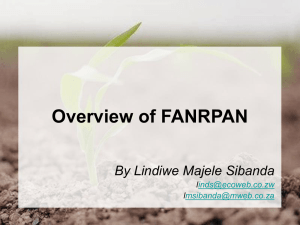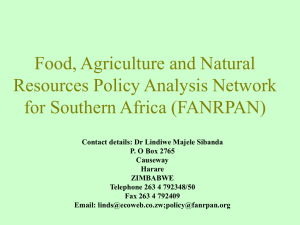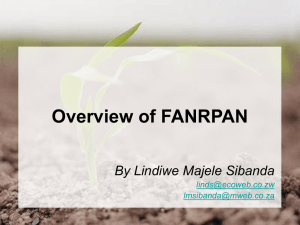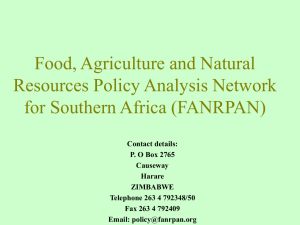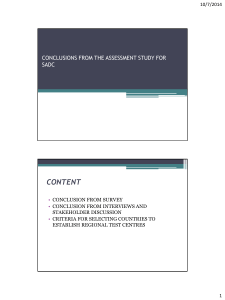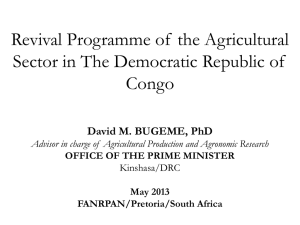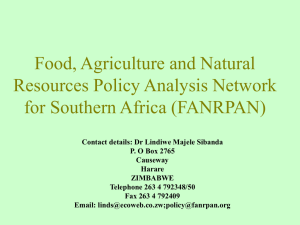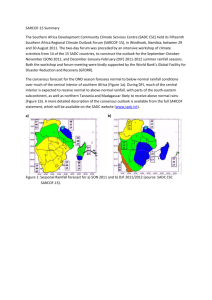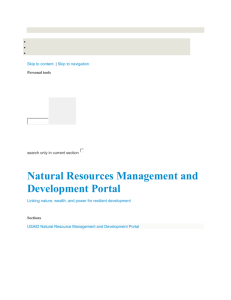FANRPAN_Generic-Allen.ppt
advertisement
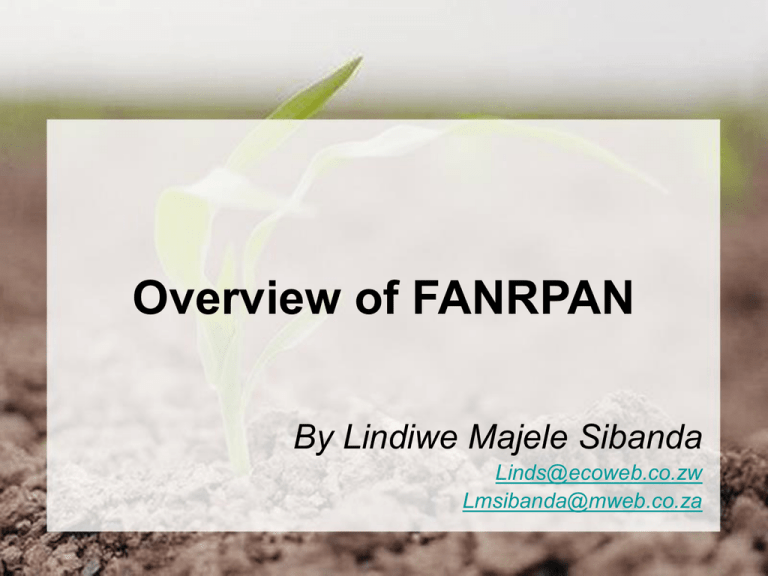
Overview of FANRPAN By Lindiwe Majele Sibanda Linds@ecoweb.co.zw Lmsibanda@mweb.co.za Highlights 1. Background – – SADC FANRPAN Establishment & Objectives 2. Mission 3. Operational Structure – – – Institutional Framework Organisational Structure Research Process 4. Current Work – – Current Studies/Programs Projects’ Timeframe 5. Key Strategies for Capacity Strengthening FANRPAN Background SADC Background • SADC region (200 million people) face food insecurity challenges. • Agriculture is the prime driver of economic development across SADC. • Agricultural investments by governments have remained low. SADC Background (ctd) • Agricultural yields for crops and livestock have been level or declining. • Food aid and imports have almost doubled in the last 10 years. • HIV/AIDS pandemic, natural disasters (droughts, floods) and civil conflicts have compromised SADC’s efforts to ensure food security. Establishment & Objectives • Against this background, SADC Ministers of Agriculture recommended the formation of FANRPAN in 1994 to: – Promote appropriate agricultural policies in order to reduce poverty – Increase food security and promote sustainable agricultural development Establishment & Objectives • FANRPAN was formed YEAR 2001 to: – Promote appropriate agricultural policies in order to reduce poverty – Increase food security and promote sustainable agricultural development – Focus on promoting regional trade and exchange of information across member states – Provide a conducive policy and legal framework, including functional input supply and markets for surplus products Mission FANRPAN Mission • To coordinate, influence and facilitate policy research, analysis and dialogue at the national, regional and global levels in order to develop the food, agriculture and natural resources sector. • The Mission is achieved through networking, capacity building and information generation for the benefit of the SADC region Operational Structure Institutional Framework • An autonomous stakeholder-driven policy research analysis and implementation network • Regional secretariat based in Harare, Zimbabwe • Strategically positioned to deal with policy aspects of food security • Represented in 11 of the 13 SADC countries through an inter-sectoral platform designated as a country node Institutional Framework FANRPAN Structure FANRPAN Research Process Country Issues Debated at Country Level Regional Synthesis Cross-cutting Issues Coordination of Regional Research Dissemination of Outputs At Country & Regional Levels Advocacy Through SADC Ministers Current Work Current Studies/Programs Impact of HIV & AIDS on Agriculture & Food Security • This is part of a five-year EU funded project • The 2 year study • Aim: determining the impact of HIV & AIDS on food security and recommend mitigation and coping strategies for adoption by Ministries of Agriculture in the region Rural Livelihoods Project in Southern Africa • FANRPAN implemented the policy module of the IITA’s “Improving Rural Livelihoods In Southern Africa Project” • Funded by USAID RCSA • Objective: Recommendations on designing policies for unlocking constraints to rural economy diversification • The project ended in October 2004 Profiling of SADC Farmer Based Organisations • Objectives 1. Strengthen the capacity of FOs in policy analysis and advocacy 2. Develop a database of FOs (Commodity Associations, Farmer Unions & Cooperatives) 3. Develop communication strategy for SACAU • FANRPAN collaborates with the Southern African Confederation of Agricultural Unions (SACAU) Biotechnology Policy Issues For Food Security • FANRPAN reviewed policies on agricultural biotechnology in 11 SADC countries & produced a regional synthesis paper • This study is part of a wider debate on the role of biotechnology in agriculture, the subject of genetically modified food and biosafety Maize Marketing Study • • This is a 2 year study undertaken in collaboration with Michigan State University Objectives: 1. Improve functioning of grain markets for small scale households 2. Regionally coordinated strategies for promotion of regional trade 3. Capacity building through mentored support of FANRPAN network economists by MSU Contract Farming • Objectives: 1. Exploit the potential of contract farming as an institution that can assist to commercialise small scale farmers 2. Develop policies & acton plans that can be used to expand the use of contract farming in SADC • Definition: arrangements linking small-sale farmers to some type of market as a way of supporting them to become successful independent commercial farmers CTA Communication & Networking • Centre for Technical Cooperation (CTA) • Support is for publications, policy dialogue and networking • 2005 annual regional policy dialogue: a showcase of FANRPAN research outputs, 4 to 8 October, Birchwood Hotel, Johannesburg Agricultural Policy Harmonisation Project • • Funded by USAID Objectives: 1. To build a strong network that is better able to respond to the policy analysis and research needs of SADC 2. To strengthen the capacity of country level policy nodes to conduct policy dialogue sessions Scope of FANRPAN Capacity Strengthening Project Governance • Full board • 3 Board meetings each year Regional Secretariat • Relocate to Pretoria • Appoint: – Program Officer – Program Assistant • Establish: – Monitoring & Evaluation System – Information & Knowledge Management System National Nodes • Zambia, Malawi, South Africa, Mozambique, Angola • Appoint country program assistants • Revitalise membership • Sign MOUs with host institutions • Coordinate FANR policy research & dialogues • Compile membership directories • Strengthen research partnerships: IFPRI, IITA, MSU, ISU, ICRISAT, CTA Harmonisation of Regional Policies • Agricultural inputs regional policy harmonisation in: – Seed trade – Fertilizer trade – HIV & AIDS policies Angola Country Node • Set up new node • Appoint Program Assistant • Develop policy research programme Sustainability Plan • Come up with – HR Plan – Financial Systems • Annual audits PROJECTS TIMEFRAME
